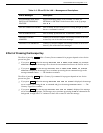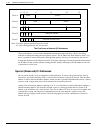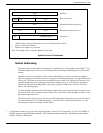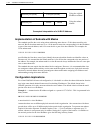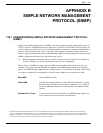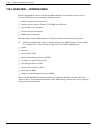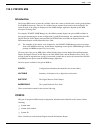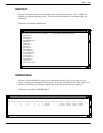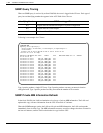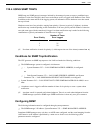
SNMP 11B-1
Octel 200/300 S.4.1PB60019−01
APPENDIX B
SIMPLE NETWORK MANAGEMENT
PROTOCOL (SNMP)
11B.1 UNDERSTANDING SIMPLE NETWORK MANAGEMENT PROTOCOL
(SNMP)
Simple Network Management Protocol (SNMP) is the standard digital network management protocol in
TCP/IP* networks. An SNMP management application is typically an off-the-shelf software package run
on a PC, terminal, or workstation by a network administrator or technician to manage and troubleshoot a
network. Octel 200/300 message servers with LAN, used for digital networking and other LAN based
features, support communication with the SNMP manager application and management information bases
(MIBs) to supply data about the Octel 200/300 message servers.
. MIB (management information base) is a directory that lists the logical names of all information
resources residing in a network and pertinent to the network’s management.
Three varieties of SNMP data support; the basic MIB, the private MIB, and hardware error traps, are
provided. Data item groups from the MIBs are supplied to the SNMP manager application as replies to
queries. The SNMP manager application may schedule queries or request them on demand. The hardware
error traps are initiated by the managed Octel 200/300 when a hardware error generates an alarm.
Internet MIB-II Standard
Specific data items that identify an Octel 200/300 and describe its digital
network traffic and hardware errors. Refer to Appendix C for a listing of
the private MIB and instructions on obtaining the private MIB file from
Internet.
A notification from the Octel 200/300 to the SNMP manager application
that a hardware error has reached an alarm threshold.
* Transmission Control Protocol/Internet Protocol. A set of communications protocols developed for the Defense Advanced Research Projects
Agency to internetwork dissimilar systems. It runs on a large number of computers and is supported by many hardware vendors from personal
computers to mainframes. It is used by many corporations and almost all American universities and federal organizations. The TCP protocol con-
trols the transfer of the data, and the IP protocol provides the routing mechanism.
Basic MIB
Private MIB
Hardware Error Traps



